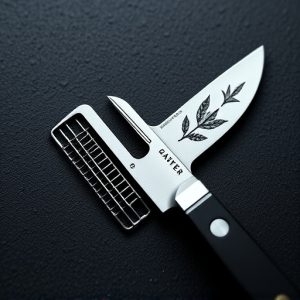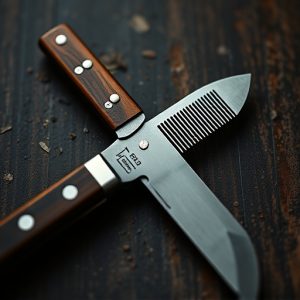Exploring the Comb with Hidden Knife: A Multi-Functional Tool’s History and Safe Use
The "comb with hidden knife," a tool of ancient Japanese origin, ingeniously combines the…….
The "comb with hidden knife," a tool of ancient Japanese origin, ingeniously combines the functions of personal grooming and self-defense. This dual-purpose instrument, which features a sharp blade concealed within its handle, has been adapted for use as a discreet weapon by law enforcement and military personnel due to its effectiveness in non-lethal self-defense. In martial arts like Karate and Aikido, practitioners employ it to target pressure points or neutralize attackers. The comb's design is user-friendly, accommodating both grooming needs and the swift deployment of the knife when necessary. Its small size and ergonomic handle make it an object of practical use as well as historical significance. Mastery of this tool requires not only selecting the right materials for the blade but also understanding its mechanics for seamless concealment and quick access. Training is crucial to ensure safe handling, effective use, and the development of muscle memory for precise actions under stress. The section highlights the importance of regular practice to maintain both the knife's covert nature and the user's proficiency with this specialized skill, emphasizing safety as a top priority in its application.
Discover the intriguing fusion of grooming and utility as we delve into the enigmatic ‘comb with hidden knife’—a tool that has captured curiosity across various cultures. This article unravels its historical context, explores its multifaceted uses, and guides you through its design and mechanisms. From understanding its origins to mastering its artful application, join us as we examine the practicality and sophistication behind this unique implement. Prepare to appreciate the ‘comb with hidden knife’ not just as a relic of ingenuity but as a modern-day marvel that combines form and function in unexpected ways.
Unraveling the Enigma of Comb with Hidden Knife: A Closer Look at the Tool's History and Uses
Throughout history, the “comb with hidden knife,” often referred to as a fighting comb or a kubotan, has been an intriguing tool, merging the functionalities of grooming and self-defense. Its origins can be traced back to ancient Japan, where it was adapted from a traditional agricultural implement known as the ‘kama.’ The evolution of this tool saw it become a discrete weapon carried by individuals for personal protection. Despite its innocuous appearance, the comb with hidden knife is designed with a sharp, concealed blade within the handle, allowing for defensive maneuvers when grooming is not the intent. Today, it remains a specialized self-defense tool in martial arts such as Karate and Aikido, where practitioners train to use it effectively in various combat scenarios. Its compact size and dual function make it an object of both practical utility and historical curiosity.
The uses of the comb with hidden knife are as varied as its history. In self-defense situations, the sharp end can be used to strike pressure points or incapacitate an attacker, while the other end serves its intended purpose for combing hair. This tool’s effectiveness lies in its ability to transform from a seemingly ordinary grooming item into a potent weapon when danger presents itself. Its adoption in various self-defense systems is a testament to its design, which balances form and function seamlessly. Law enforcement and military personnel have also recognized the comb with hidden knife as a non-lethal means of self-protection, further cementing its place within protective and tactical contexts. The tool’s ability to blend into everyday carry without raising suspicion makes it an attractive option for those seeking an unassuming yet effective self-defense device.
The Anatomy of a Comb with Hidden Knife: Understanding Its Design and Mechanisms
The “comb with hidden knife” is a multifunctional tool that ingeniously integrates a cutting edge within the structure of what appears to be an ordinary comb. This design combines utility and stealth, allowing the user to carry both grooming and defensive capabilities discreetly. The comb aspect serves its primary function for personal care, detangling hair with its wide-tooth or fine-toothed rows, while the knife remains concealed within the handle or the base of the comb until needed.
Crafted with precision, the hidden knife is typically a razor-sharp blade that is meticulously placed within the comb’s body to avoid detection. The design often features a small release mechanism that, when activated, allows the user to deploy the knife swiftly and efficiently. The ergonomics of the handle are carefully considered to ensure a secure grip that can endure both routine use for combing and the application of force required to reveal the blade. The integration of these two elements requires a sophisticated understanding of material strength, mechanics, and design aesthetics to maintain both functionality and concealment. Users must be trained in its proper use to handle this tool responsibly, recognizing the dual nature it holds as both an everyday item and a potential self-defense weapon.
Mastering the Art of Using a Comb with Hidden Knife Safely and Effectively
Mastery of the comb with a concealed knife requires a blend of skill, precision, and discretion. The practice is an art form that has been employed for various reasons, ranging from self-defense to practical applications in performance arts. To safely and effectively wield a comb with a hidden knife, one must first understand the mechanics and materials involved. The knife should be compact yet sharp enough to fulfill its purpose without drawing unnecessary attention. It should be securely integrated into the comb’s design, ensuring that it is not only concealed but also accessible when needed.
Training in this skill involves a careful balance between handling the comb as an everyday tool and being prepared for situations that may require self-defense. Practitioners must develop a keen sense of awareness and control, allowing them to maintain composure even under pressure. The integration of the knife within the comb necessitates precise movements; users must learn to manipulate both tools with confidence and finesse. Regular practice is crucial for muscle memory development, enabling the user to execute necessary actions swiftly and accurately. Safety in this context means not only avoiding injury during practice but also ensuring that the knife remains undetected until its use becomes absolutely necessary.


